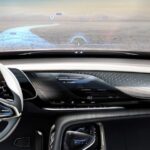While there aren’t any car brands that begin with the letter Z currently in production, the letter Z does play a crucial role in the automotive world, particularly in remote car starters utilizing Z-Wave technology. Specifically, the “Z-Wave Virtual Momentary Contact Switch” is a key component in many smart home integrations for vehicle remote start systems. This article delves into the functionality and code behind this essential device.
Understanding the Z-Wave Virtual Momentary Contact Switch
Timing is critical when it comes to remote car starters. A discrepancy of even a few seconds can be the difference between a successful start and a damaged starter motor. A reliable device, rather than a smartphone app, offers greater precision for this task. The Z-Wave Virtual Momentary Contact Switch acts as a digital intermediary, sending a brief “pulse” to trigger the starter. This momentary action is crucial for preventing damage. Using a dedicated device ensures accuracy in timing these signals.
The Z-Wave Virtual Momentary Contact Switch, often integrated with platforms like SmartThings, provides a reliable solution. This device allows for customization, including adjusting the pulse duration (the “on” time) for optimal starter engagement. A common adjustment is increasing the delay from the default 0.5 seconds to around 3 seconds.
Code Breakdown for the Z-Wave Virtual Momentary Contact Switch
Below is an example of the code that powers a Z-Wave Virtual Momentary Contact Switch within a SmartThings environment:
/** * SmartSense Virtual Momentary Contact Switch * * Author: SmartThings * Date: 2013-03-07 */ metadata { // Automatically generated. Make future change here. definition (name: "Z-Wave Virtual Momentary Contact Switch", namespace: "smartthings", author: "SmartThings") { capability "Actuator" capability "Switch" capability "Refresh" capability "Momentary" capability "Sensor" capability "Relay Switch" } // simulator metadata simulator { status "on": "command: 2003, payload: FF" status "off": "command: 2003, payload: 00" // reply messages reply "2001FF,2502,delay 2000,200100,2502": "command: 2503, payload: FF" reply "200100,2502": "command: 2503, payload: 00" } // tile definitions tiles { standardTile("switch", "device.switch", width: 2, height: 2, canChangeIcon: true) { state "off", label: '${name}', action: "momentary.push", icon: "st.switches.switch.off", backgroundColor: "#ffffff" state "on", label: '${name}', action: "switch.off", icon: "st.switches.switch.on", backgroundColor: "#79b821" } standardTile("refresh", "device.switch", inactiveLabel: false, decoration: "flat") { state "default", label:'', action:"refresh.refresh", icon:"st.secondary.refresh" } main "switch" details(["switch","refresh"]) } } def parse(String description) { def result = null def cmd = zwave.parse(description, [0x20: 1]) if (cmd) { result = createEvent(zwaveEvent(cmd)) } log.debug "Parse returned ${result?.descriptionText}" return result } def zwaveEvent(physicalgraph.zwave.commands.basicv1.BasicReport cmd) { [name: "switch", value: cmd.value ? "on" : "off", type: "physical"] } def zwaveEvent(physicalgraph.zwave.commands.switchbinaryv1.SwitchBinaryReport cmd) { [name: "switch", value: cmd.value ? "on" : "off", type: "digital"] } def zwaveEvent(physicalgraph.zwave.commands.manufacturerspecificv2.ManufacturerSpecificReport cmd) { if (state.manufacturer != cmd.manufacturerName) { updateDataValue("manufacturer", cmd.manufacturerName) } final relays = [ [manufacturerId:0x0113, productTypeId: 0x5246, productId: 0x3133, productName: "Evolve LFM-20"], [manufacturerId:0x5254, productTypeId: 0x8000, productId: 0x0002, productName: "Remotec ZFM-80"] ] def productName = null for (it in relays) { if (it.manufacturerId == cmd.manufacturerId && it.productTypeId == cmd.productTypeId && it.productId == cmd.productId) { productName = it.productName break } } if (productName) { log.debug "Relay found: $productName" updateDataValue("productName", productName) } [name: "manufacturer", value: cmd.manufacturerName] } def zwaveEvent(physicalgraph.zwave.Command cmd) { // Handles all Z-Wave commands we aren't interested in [:] } def push() { def cmds = [ zwave.basicV1.basicSet(value: 0xFF).format(), zwave.switchBinaryV1.switchBinaryGet().format(), "delay 3000", zwave.basicV1.basicSet(value: 0x00).format(), zwave.switchBinaryV1.switchBinaryGet().format() ] } def on() { push() } def off() { [ zwave.basicV1.basicSet(value: 0x00).format(), zwave.switchBinaryV1.switchBinaryGet().format() ] } def refresh() { delayBetween([ zwave.switchBinaryV1.switchBinaryGet().format(), zwave.manufacturerSpecificV1.manufacturerSpecificGet().format() ]) } def on() { push() } def off() { [ zwave.basicV1.basicSet(value: 0x00).format(), zwave.switchBinaryV1.switchBinaryGet().format() ] } def poll() { zwave.switchBinaryV1.switchBinaryGet().format() } def refresh() { zwave.switchBinaryV1.switchBinaryGet().format() }This code defines how the switch behaves, how it communicates with the Z-Wave network, and how it integrates with the SmartThings platform. Key elements include defining capabilities, handling Z-Wave commands, and setting the momentary pulse action with a specified delay.
Conclusion: Z-Wave’s Role in Modern Car Starters
While a car brand starting with Z might not exist, Z-Wave technology plays a significant part in enhancing the car ownership experience. The Z-Wave Virtual Momentary Contact Switch enables reliable and customizable remote starting, highlighting the innovative ways technology integrates with our vehicles. Understanding the core functionality of this device, along with its code implementation, provides valuable insight into the complexities of modern car starter systems.


